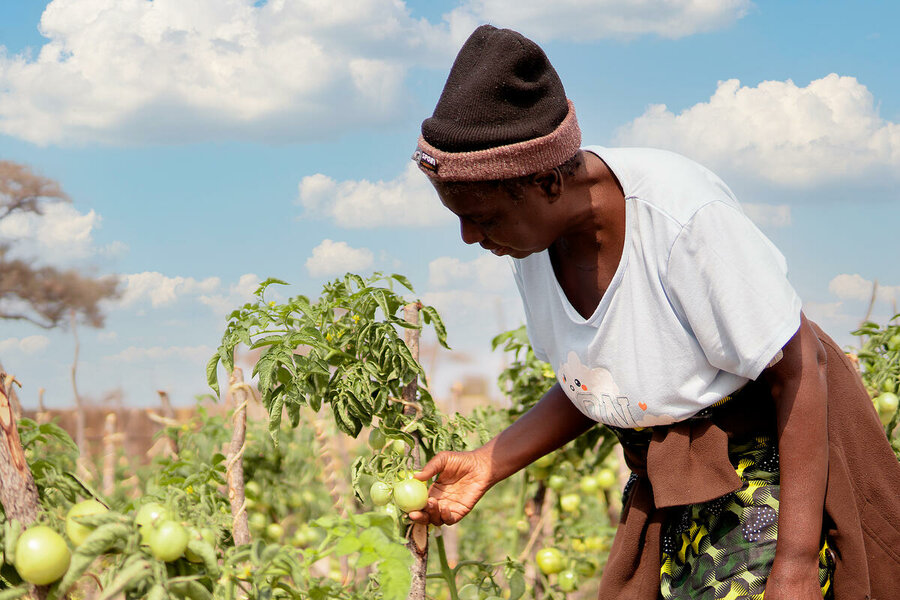COP27: Three ways to stop the climate crisis whipping up a hunger storm
The climate crisis is pushing more and more people to the brink in a year of unprecedented hunger. Heatwaves, droughts, floods and storms are increasing in intensity and frequency, impacting people’s ability to feed their families.
In contexts such as Yemen, Somalia and the Democratic Republic of Congo, where climate impacts intersect with conflict, famine is an ever-present threat.
So, as world leaders prepare to gather in Sharm el-Sheikh in Egypt for the 2022 United Nations Climate Change Conference (COP27) between 6 and 18 November, the World Food Programme (WFP) is calling for urgent action to support those on the frontlines of the climate emergency.
Here are three things they must focus on:
1. Scale up climate adaptation and solutions to avert, minimize and address loss and damage

From devastating floods in Pakistan affecting one in seven people in the country, to consecutive droughts pushing people to the edge of famine in the Horn of Africa, extreme weather events are happening in every region of the world.
Communities need solutions to protect themselves and their ability to access enough food. Global leaders must invest in systems that predict climate hazards and provide physical and financial protection to the most vulnerable.

Ahead of recent floods in Nepal, for example, WFP triggered its anticipatory action programme – which uses early warning systems to ensure action before disasters hit – transferring cash to more than 15,000 people across three of the hardest hit districts. The funds helped communities to prepare for the floods, protect themselves and prevent losses and damages; for example, by buying food, reinforcing homes or moving vulnerable people to higher ground.
2. Invest in climate action in communities in fragile contexts

Those living on the frontlines of climate change are often also impacted by conflict, displacement and social inequalities. These communities need the most support, yet they receive the least. Over the past seven years, non-fragile states received 80 times more climate finance per person than extremely fragile states.
To tackle the climate crisis and ensure everyone has enough food to eat, we must prioritize action and funding for vulnerable and conflict-hit areas, supporting communities to adapt to a changing climate, while also building peace.
WFP projects focus on both. For instance, in Somalia earlier this year, knowing the country would continue to be gripped by extreme drought, WFP worked with the Government to deliver early-warning messages to 1.2 million people. WFP also reached 17,000 vulnerable people living in remote areas with cash transfers, to better protect their lives and livelihoods.
As Somalia faces the imminent threat of famine in parts of the country, prioritizing climate action for the most vulnerable communities is more important than ever.
3. Transform food systems

The range of activities that produce, process and transport food to our tables are neither equitable or sustainable. On the one hand, extreme weather events cause destruction right across food systems; on the other, food systems are leading contributors to global heating. Agriculture, transportation and cooking all contribute significant, harmful emissions that are raising the temperature of our planet.
The lack of diversity in our food systems, reliance on polluting practices and exposure to disruptions such as conflict, are threatening global food security. A record 345 million people in 82 countries currently face acute hunger – up from 282 million at the start of the year.
This does not need to be a downward spiral. We know the world has enough food for everyone if it were simply distributed equitably. We also have the knowledge, technology and innovative solutions to reverse the negative relationship between food systems and climate change.
What WFP is doing

Across 123 countries and territories, WFP supports communities facing some of the worst impacts of extreme weather events to build their resilience in a changing climate.
We work with local governments to anticipate climate hazards before they turn into disasters, restore degraded ecosystems and infrastructure, protect the most vulnerable with financial safety nets and give people new opportunities to farm, cook and power their homes through access to clean energy.
In five Sahel countries of West and Central Africa – Burkina Faso, Chad, Mali, Mauritania and Niger – WFP implements an integrated resilience programme that supports climate adaptation whilst also protecting food systems.

In practice this means rehabilitating land, improving peoples’ access to food and healthy diets, getting children back into school and developing value chains to boost incomes and green jobs.
For example, despite rising insecurity in the region, WFP and communities have rehabilitated nearly 158,000 hectares of degraded land in the Sahel over the past four years through initiatives like digging ‘half moons’ – which catch and keep rainfall in the soil.
With increased ambition and political will, we can diversify, decarbonize and improve the resilience of our food systems to simultaneously tackle the climate crisis and food insecurity.
World leaders have a huge challenge ahead of them, but with coordinated global action, we can tackle the climate crisis.
COP27 takes place in Sharm el-Sheikh Egypt 6-18 November.
